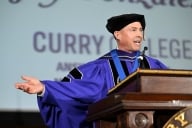You have /5 articles left.
Sign up for a free account or log in.
When Bucknell University in January admitted that it had been reporting false SAT averages to U.S. News & World Report (and others), it followed a flurry of similar confessions over the previous 12 months.
Since then, several months have since passed. Until Monday, no other colleges had come forward to admit that they too had been submitting false numbers. But York College of Pennsylvania did so on Monday.
The college announced that it had developed a program some years ago to admit students with lower-than-average SAT scores but high achievement in challenging high school courses. These students typically had combined mathematics-verbal SAT scores in the 800-950 range. These students' SAT scores, the lowest of admitted students, were excluded from the college's calculations. York refers to these as "special admissions" students. When all students were included for this year's freshman class, York's SAT average drops from the 1081 to 1052.
A statement from the college offered this explanation: "In the past, it was not unusual for colleges to exclude the scores of such students in the SAT report, and that was true for York. While these scores were not reported to agencies, they were utilized internally for course placement and eligibility for specific majors. The scores were not reported because they were not relied on for the decision to admit. Reporting standards in college admissions in recent years have called for the inclusion of all new incoming student SAT scores, including summer enrollees and special admits."
The York statement said that a "recent internal data review" had led to the discovery that incorrect SAT averages were being used.
A York spokeswoman said that the college was sending corrected information not only to U.S. News but also to others that had received incorrect data, including the Integrated Postsecondary Education Data System, the National Center for Educational Statistics and Standard & Poor’s.
The college's statement that excluding some groups from SAT averages was "not unusual" in "the past" is true if referring to more than a few years ago. As the influence of the rankings took off in the 1990s, there were numerous reports about the ways that colleges -- including many prominent institutions -- excluded large shares of the student body (generally those with lower SAT averages) from the calculations. This 1995 article from The Wall Street Journal is typical of the kind of reporting that embarrassed those doing rankings into being more specific that all students needed to be counted.
These days, there is little ambiguity in the U.S. News definitions that would allow a college to exclude any students. The U.S. News methodology says that SAT and ACT averages are calculated based on "all enrolled first-time, first-year students."
Likewise the statement of "best practices" adopted by the National Association for College Admission Counseling says that data should cover "all" students. (NACAC actually doesn't recommend reporting single averages, preferring that colleges report the middle 50 percent of scores, but in that report, the association wants all students counted.)
Robert Morse, head of the U.S. News college rankings, said he did not believe the magazine had been informed of York's data issues, and that he would look into it.
In 2012, Claremont McKenna College, Emory University and George Washington University all submitted false data to U.S. News about undergraduate admissions, as did Tulane University's business school with regard to M.B.A. admissions.








